Artificial Intelligence for the American People: Case Study Analysis
VerifiedAdded on 2023/01/13
|8
|1498
|28
Report
AI Summary
This report examines the potential of Artificial Intelligence (AI) to benefit the American people, focusing on the White House summit held on May 10, 2018. It analyzes the summit's key objectives, including supporting AI-based R&D, developing the American workforce, removing barriers to innovation, and enabling sector-specific AI applications. The report discusses the Trump administration's prioritization of AI research and infrastructure, and its strategies for workforce training and technological advancement. Furthermore, the report delves into the ethical implications of AI by applying four classical theories: deontology, utilitarianism, virtue ethics, and contractual theory. It concludes that AI technology holds significant promise for the American workforce and emphasizes the importance of ethical considerations and government investment in research and development to overcome challenges and maximize the benefits of AI.
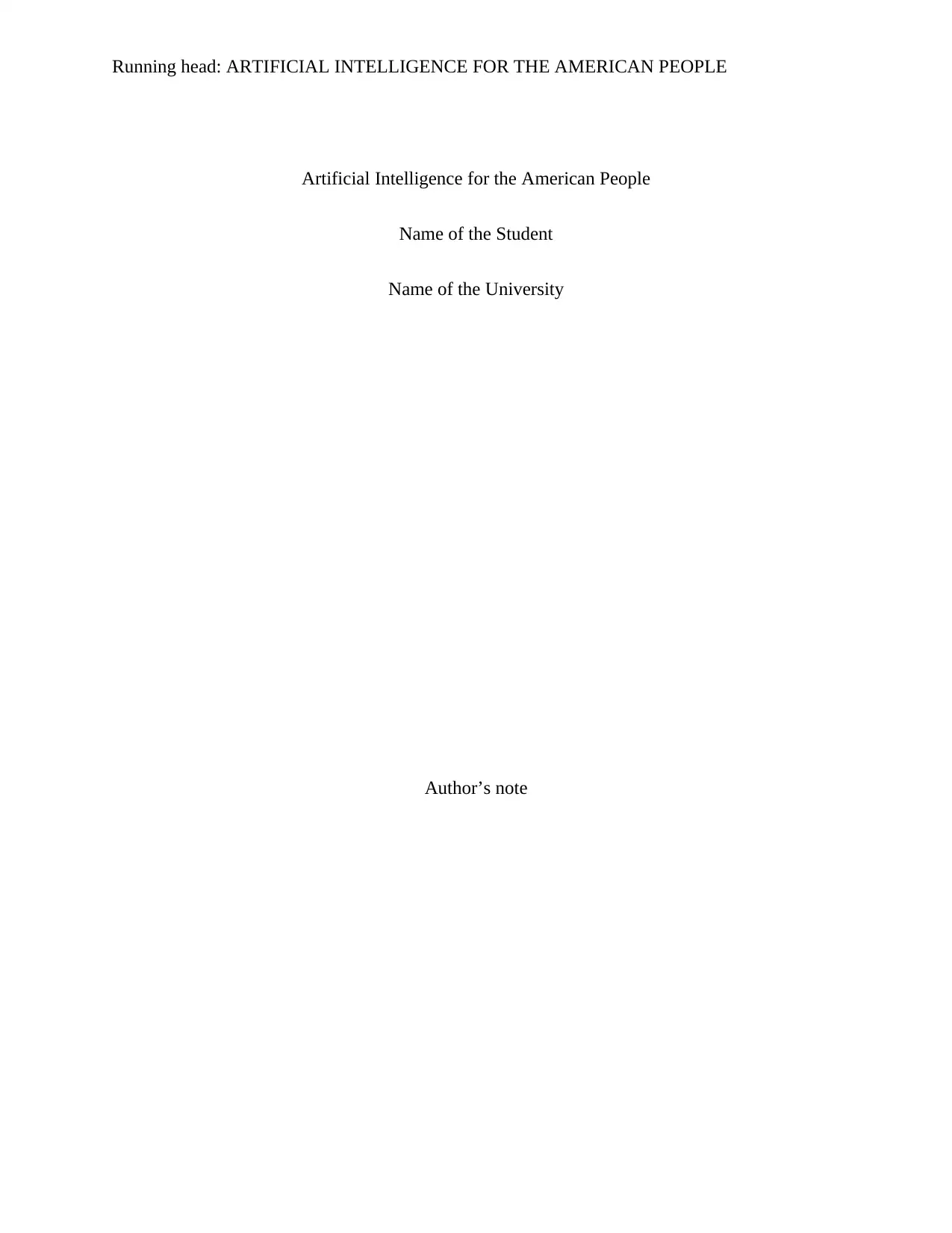
Running head: ARTIFICIAL INTELLIGENCE FOR THE AMERICAN PEOPLE
Artificial Intelligence for the American People
Name of the Student
Name of the University
Author’s note
Artificial Intelligence for the American People
Name of the Student
Name of the University
Author’s note
Paraphrase This Document
Need a fresh take? Get an instant paraphrase of this document with our AI Paraphraser

1ARTIFICIAL INTELLIGENCE FOR THE AMERICAN PEOPLE
Table of Contents
1. Introduction..................................................................................................................................2
2. Discussion....................................................................................................................................2
2.1 Analysis of the Case Study....................................................................................................2
2.2 Considering of the four Classical Theories...........................................................................3
2.3 Argument Visualisation of the Discussion............................................................................5
3. Conclusion...................................................................................................................................6
References........................................................................................................................................7
Table of Contents
1. Introduction..................................................................................................................................2
2. Discussion....................................................................................................................................2
2.1 Analysis of the Case Study....................................................................................................2
2.2 Considering of the four Classical Theories...........................................................................3
2.3 Argument Visualisation of the Discussion............................................................................5
3. Conclusion...................................................................................................................................6
References........................................................................................................................................7
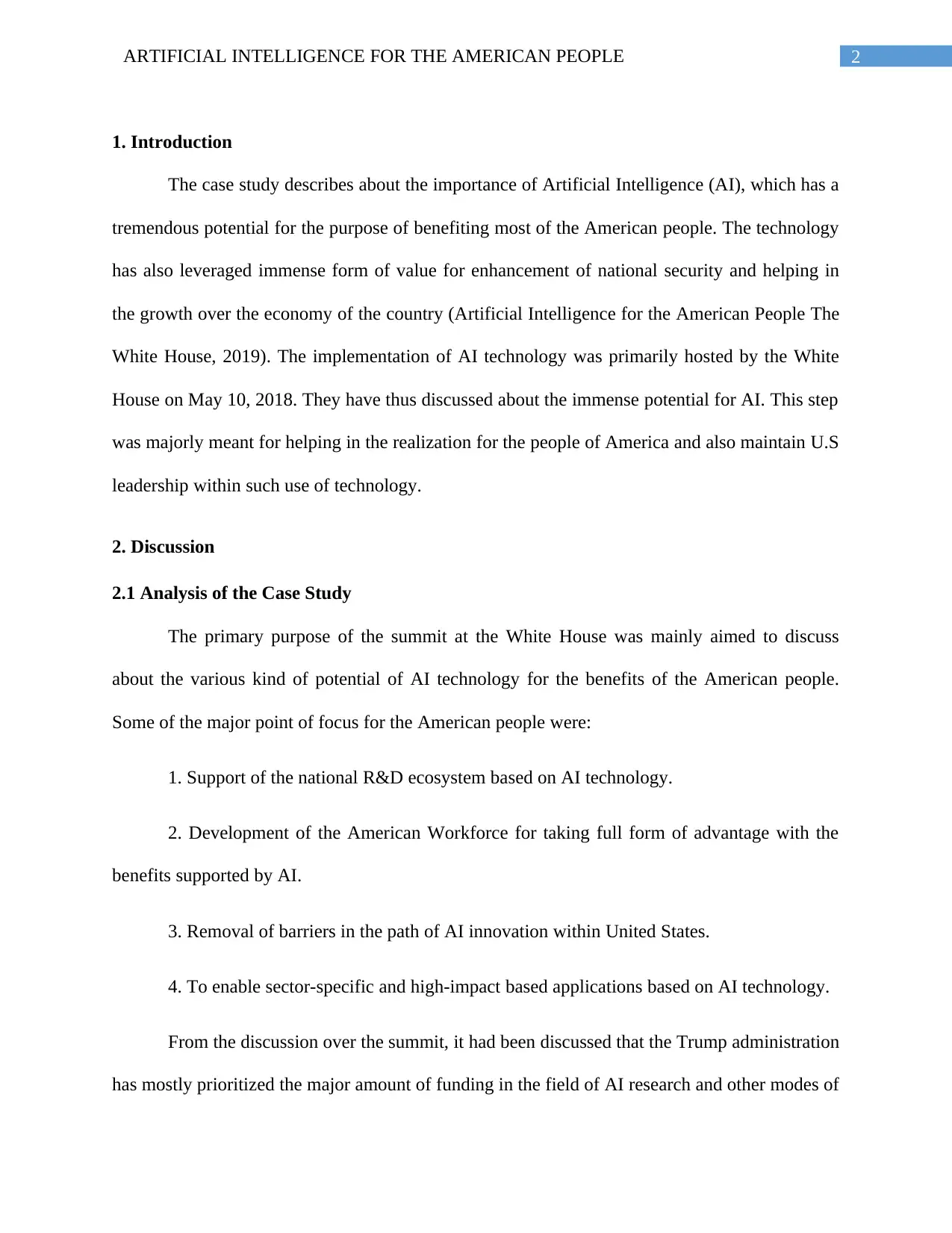
2ARTIFICIAL INTELLIGENCE FOR THE AMERICAN PEOPLE
1. Introduction
The case study describes about the importance of Artificial Intelligence (AI), which has a
tremendous potential for the purpose of benefiting most of the American people. The technology
has also leveraged immense form of value for enhancement of national security and helping in
the growth over the economy of the country (Artificial Intelligence for the American People The
White House, 2019). The implementation of AI technology was primarily hosted by the White
House on May 10, 2018. They have thus discussed about the immense potential for AI. This step
was majorly meant for helping in the realization for the people of America and also maintain U.S
leadership within such use of technology.
2. Discussion
2.1 Analysis of the Case Study
The primary purpose of the summit at the White House was mainly aimed to discuss
about the various kind of potential of AI technology for the benefits of the American people.
Some of the major point of focus for the American people were:
1. Support of the national R&D ecosystem based on AI technology.
2. Development of the American Workforce for taking full form of advantage with the
benefits supported by AI.
3. Removal of barriers in the path of AI innovation within United States.
4. To enable sector-specific and high-impact based applications based on AI technology.
From the discussion over the summit, it had been discussed that the Trump administration
has mostly prioritized the major amount of funding in the field of AI research and other modes of
1. Introduction
The case study describes about the importance of Artificial Intelligence (AI), which has a
tremendous potential for the purpose of benefiting most of the American people. The technology
has also leveraged immense form of value for enhancement of national security and helping in
the growth over the economy of the country (Artificial Intelligence for the American People The
White House, 2019). The implementation of AI technology was primarily hosted by the White
House on May 10, 2018. They have thus discussed about the immense potential for AI. This step
was majorly meant for helping in the realization for the people of America and also maintain U.S
leadership within such use of technology.
2. Discussion
2.1 Analysis of the Case Study
The primary purpose of the summit at the White House was mainly aimed to discuss
about the various kind of potential of AI technology for the benefits of the American people.
Some of the major point of focus for the American people were:
1. Support of the national R&D ecosystem based on AI technology.
2. Development of the American Workforce for taking full form of advantage with the
benefits supported by AI.
3. Removal of barriers in the path of AI innovation within United States.
4. To enable sector-specific and high-impact based applications based on AI technology.
From the discussion over the summit, it had been discussed that the Trump administration
has mostly prioritized the major amount of funding in the field of AI research and other modes of
⊘ This is a preview!⊘
Do you want full access?
Subscribe today to unlock all pages.

Trusted by 1+ million students worldwide
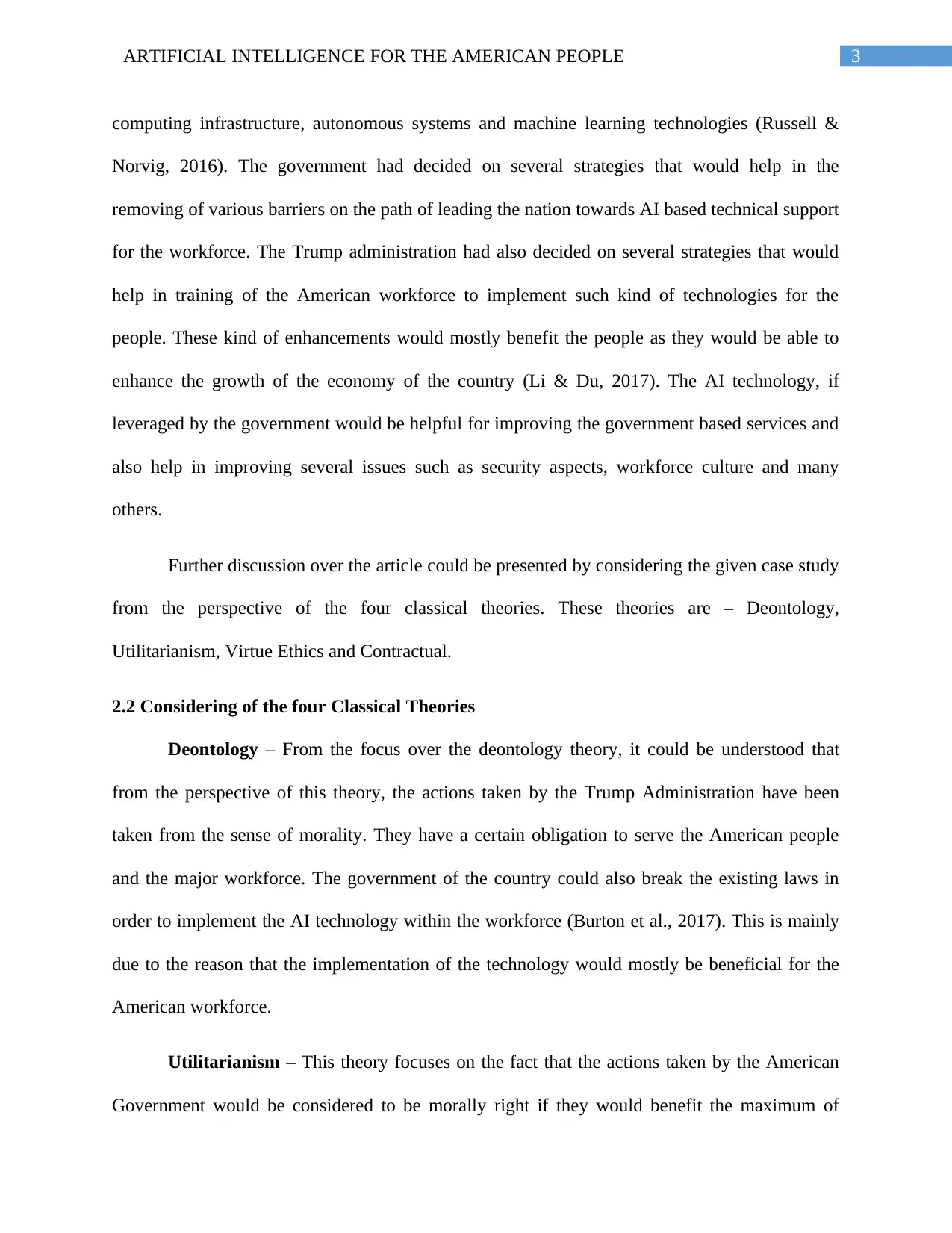
3ARTIFICIAL INTELLIGENCE FOR THE AMERICAN PEOPLE
computing infrastructure, autonomous systems and machine learning technologies (Russell &
Norvig, 2016). The government had decided on several strategies that would help in the
removing of various barriers on the path of leading the nation towards AI based technical support
for the workforce. The Trump administration had also decided on several strategies that would
help in training of the American workforce to implement such kind of technologies for the
people. These kind of enhancements would mostly benefit the people as they would be able to
enhance the growth of the economy of the country (Li & Du, 2017). The AI technology, if
leveraged by the government would be helpful for improving the government based services and
also help in improving several issues such as security aspects, workforce culture and many
others.
Further discussion over the article could be presented by considering the given case study
from the perspective of the four classical theories. These theories are – Deontology,
Utilitarianism, Virtue Ethics and Contractual.
2.2 Considering of the four Classical Theories
Deontology – From the focus over the deontology theory, it could be understood that
from the perspective of this theory, the actions taken by the Trump Administration have been
taken from the sense of morality. They have a certain obligation to serve the American people
and the major workforce. The government of the country could also break the existing laws in
order to implement the AI technology within the workforce (Burton et al., 2017). This is mainly
due to the reason that the implementation of the technology would mostly be beneficial for the
American workforce.
Utilitarianism – This theory focuses on the fact that the actions taken by the American
Government would be considered to be morally right if they would benefit the maximum of
computing infrastructure, autonomous systems and machine learning technologies (Russell &
Norvig, 2016). The government had decided on several strategies that would help in the
removing of various barriers on the path of leading the nation towards AI based technical support
for the workforce. The Trump administration had also decided on several strategies that would
help in training of the American workforce to implement such kind of technologies for the
people. These kind of enhancements would mostly benefit the people as they would be able to
enhance the growth of the economy of the country (Li & Du, 2017). The AI technology, if
leveraged by the government would be helpful for improving the government based services and
also help in improving several issues such as security aspects, workforce culture and many
others.
Further discussion over the article could be presented by considering the given case study
from the perspective of the four classical theories. These theories are – Deontology,
Utilitarianism, Virtue Ethics and Contractual.
2.2 Considering of the four Classical Theories
Deontology – From the focus over the deontology theory, it could be understood that
from the perspective of this theory, the actions taken by the Trump Administration have been
taken from the sense of morality. They have a certain obligation to serve the American people
and the major workforce. The government of the country could also break the existing laws in
order to implement the AI technology within the workforce (Burton et al., 2017). This is mainly
due to the reason that the implementation of the technology would mostly be beneficial for the
American workforce.
Utilitarianism – This theory focuses on the fact that the actions taken by the American
Government would be considered to be morally right if they would benefit the maximum of
Paraphrase This Document
Need a fresh take? Get an instant paraphrase of this document with our AI Paraphraser

4ARTIFICIAL INTELLIGENCE FOR THE AMERICAN PEOPLE
American workforce. From the perspective of the theory, it has been confirmed that the rightness
of the actions taken by the American Government could be considered to be appropriate on the
basis of the consequences of pain or pleasure for the people (Baum, 2017). From the objectives
set by the American government, it can be confirmed that the actions taken by the government
based on the implementation of AI technology have been considered as to be appropriate. These
would further be able to produce good effects for the benefit of the American workforce and thus
would [produce common good.
Virtue Ethics – Unlike the other two discussed theories, the virtue theory also focus over
the development of good habits that would be employed within the workforce (Conitzer et al.,
2017). With the implementation of AI technology within the workforce, it would prove to
leverage a vast amount of good culture within the people. Based on the use of the technology, the
people in the American workforce would decide on the best and positive factors that would
effect on them (Bostrom & Yudkowsky, 2014). There would be several improvements in the
good habits focused over the people. These technologies would also implement several good
policies that would help in beating challenges that are incurred for the government.
Contractual – The social contractual theory discusses over the factor that the people
within the American workforce would work together in the society. They would work together in
agreement, which would help in establishing political and moral rules of behaviour (Gunning,
2017). The implementation of AI technology would focus on several factors such as research and
development over the issues faced within the countries. These kind of enhancements would
leverage the technology for the betterment of the Nation.
American workforce. From the perspective of the theory, it has been confirmed that the rightness
of the actions taken by the American Government could be considered to be appropriate on the
basis of the consequences of pain or pleasure for the people (Baum, 2017). From the objectives
set by the American government, it can be confirmed that the actions taken by the government
based on the implementation of AI technology have been considered as to be appropriate. These
would further be able to produce good effects for the benefit of the American workforce and thus
would [produce common good.
Virtue Ethics – Unlike the other two discussed theories, the virtue theory also focus over
the development of good habits that would be employed within the workforce (Conitzer et al.,
2017). With the implementation of AI technology within the workforce, it would prove to
leverage a vast amount of good culture within the people. Based on the use of the technology, the
people in the American workforce would decide on the best and positive factors that would
effect on them (Bostrom & Yudkowsky, 2014). There would be several improvements in the
good habits focused over the people. These technologies would also implement several good
policies that would help in beating challenges that are incurred for the government.
Contractual – The social contractual theory discusses over the factor that the people
within the American workforce would work together in the society. They would work together in
agreement, which would help in establishing political and moral rules of behaviour (Gunning,
2017). The implementation of AI technology would focus on several factors such as research and
development over the issues faced within the countries. These kind of enhancements would
leverage the technology for the betterment of the Nation.
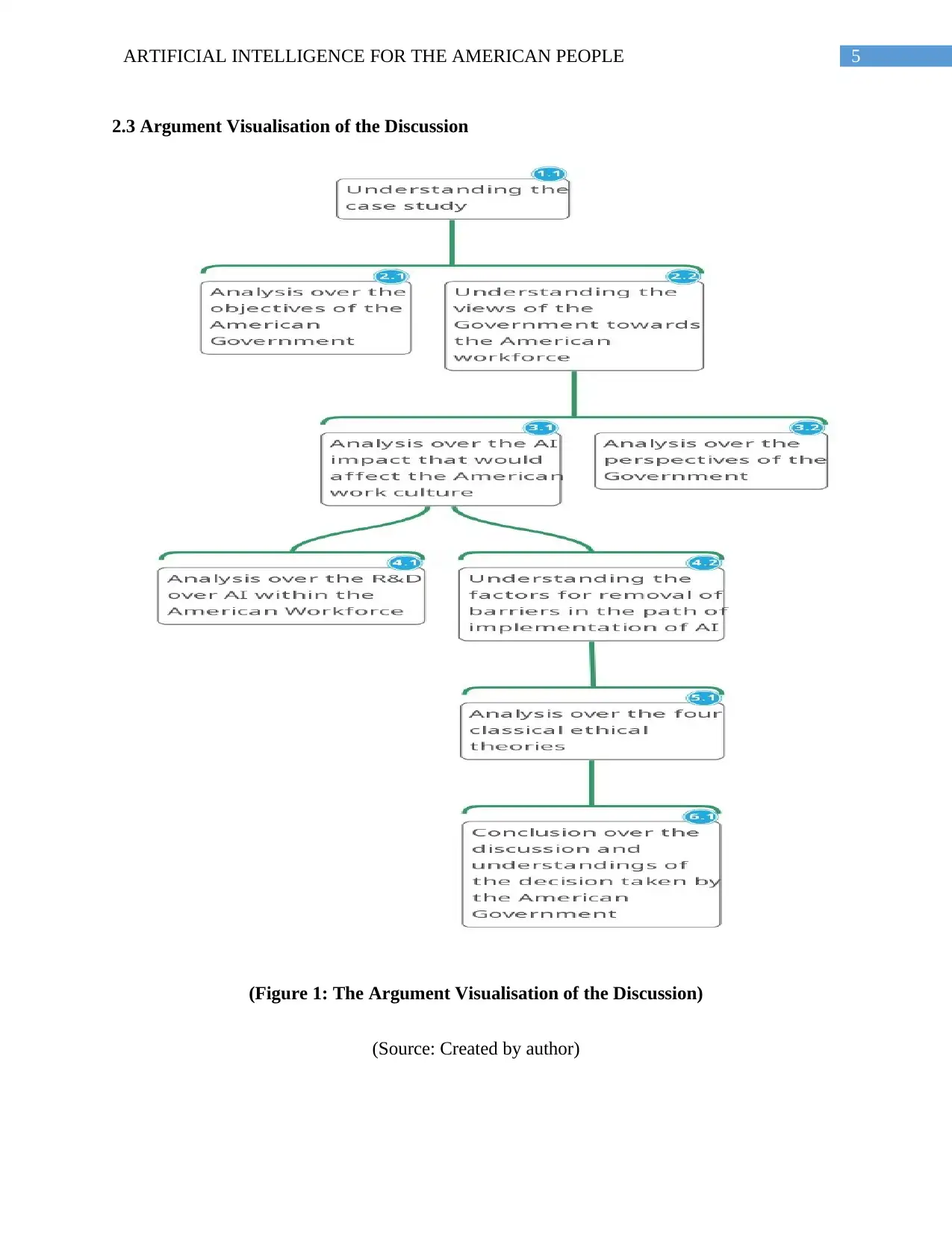
5ARTIFICIAL INTELLIGENCE FOR THE AMERICAN PEOPLE
2.3 Argument Visualisation of the Discussion
(Figure 1: The Argument Visualisation of the Discussion)
(Source: Created by author)
2.3 Argument Visualisation of the Discussion
(Figure 1: The Argument Visualisation of the Discussion)
(Source: Created by author)
⊘ This is a preview!⊘
Do you want full access?
Subscribe today to unlock all pages.

Trusted by 1+ million students worldwide
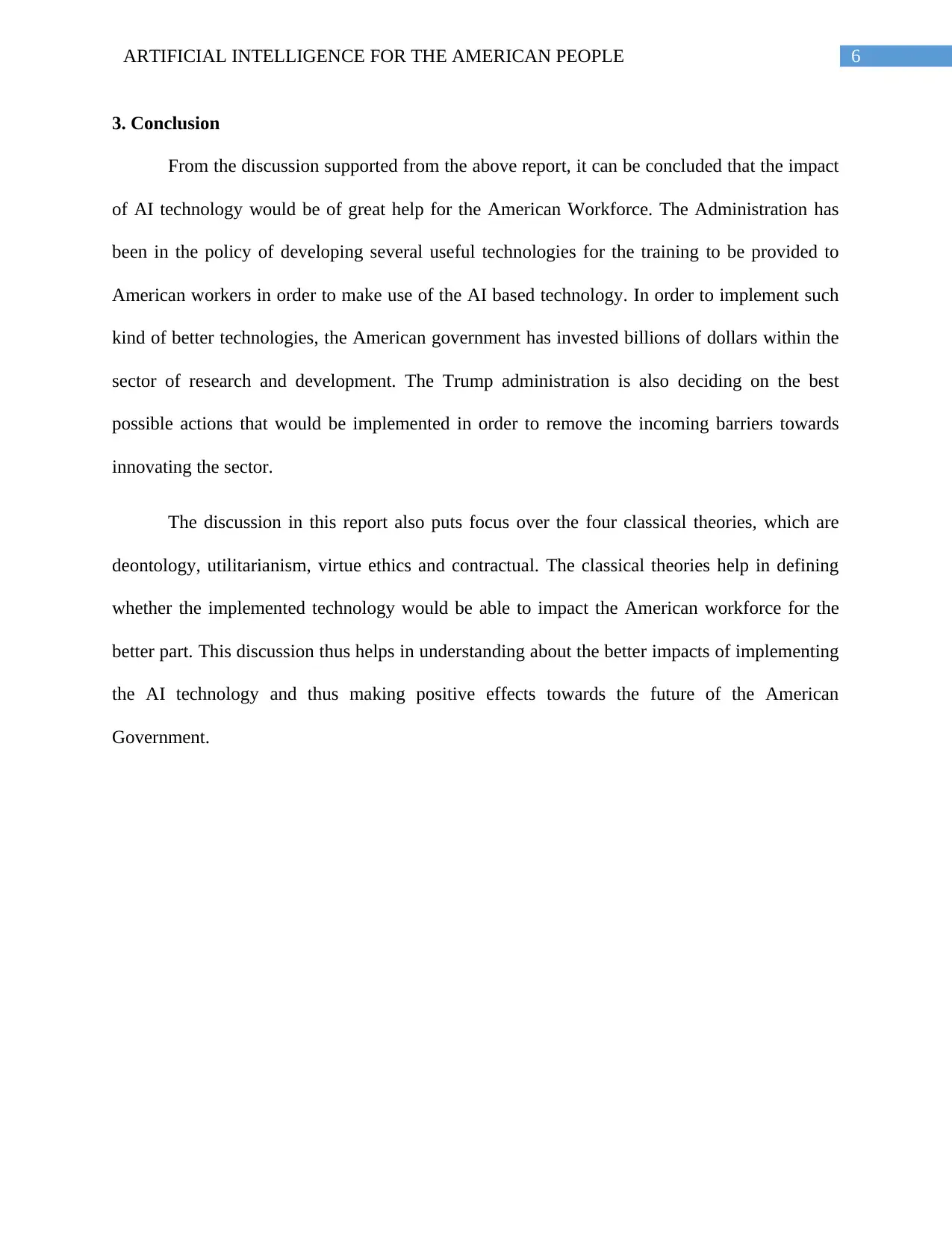
6ARTIFICIAL INTELLIGENCE FOR THE AMERICAN PEOPLE
3. Conclusion
From the discussion supported from the above report, it can be concluded that the impact
of AI technology would be of great help for the American Workforce. The Administration has
been in the policy of developing several useful technologies for the training to be provided to
American workers in order to make use of the AI based technology. In order to implement such
kind of better technologies, the American government has invested billions of dollars within the
sector of research and development. The Trump administration is also deciding on the best
possible actions that would be implemented in order to remove the incoming barriers towards
innovating the sector.
The discussion in this report also puts focus over the four classical theories, which are
deontology, utilitarianism, virtue ethics and contractual. The classical theories help in defining
whether the implemented technology would be able to impact the American workforce for the
better part. This discussion thus helps in understanding about the better impacts of implementing
the AI technology and thus making positive effects towards the future of the American
Government.
3. Conclusion
From the discussion supported from the above report, it can be concluded that the impact
of AI technology would be of great help for the American Workforce. The Administration has
been in the policy of developing several useful technologies for the training to be provided to
American workers in order to make use of the AI based technology. In order to implement such
kind of better technologies, the American government has invested billions of dollars within the
sector of research and development. The Trump administration is also deciding on the best
possible actions that would be implemented in order to remove the incoming barriers towards
innovating the sector.
The discussion in this report also puts focus over the four classical theories, which are
deontology, utilitarianism, virtue ethics and contractual. The classical theories help in defining
whether the implemented technology would be able to impact the American workforce for the
better part. This discussion thus helps in understanding about the better impacts of implementing
the AI technology and thus making positive effects towards the future of the American
Government.
Paraphrase This Document
Need a fresh take? Get an instant paraphrase of this document with our AI Paraphraser
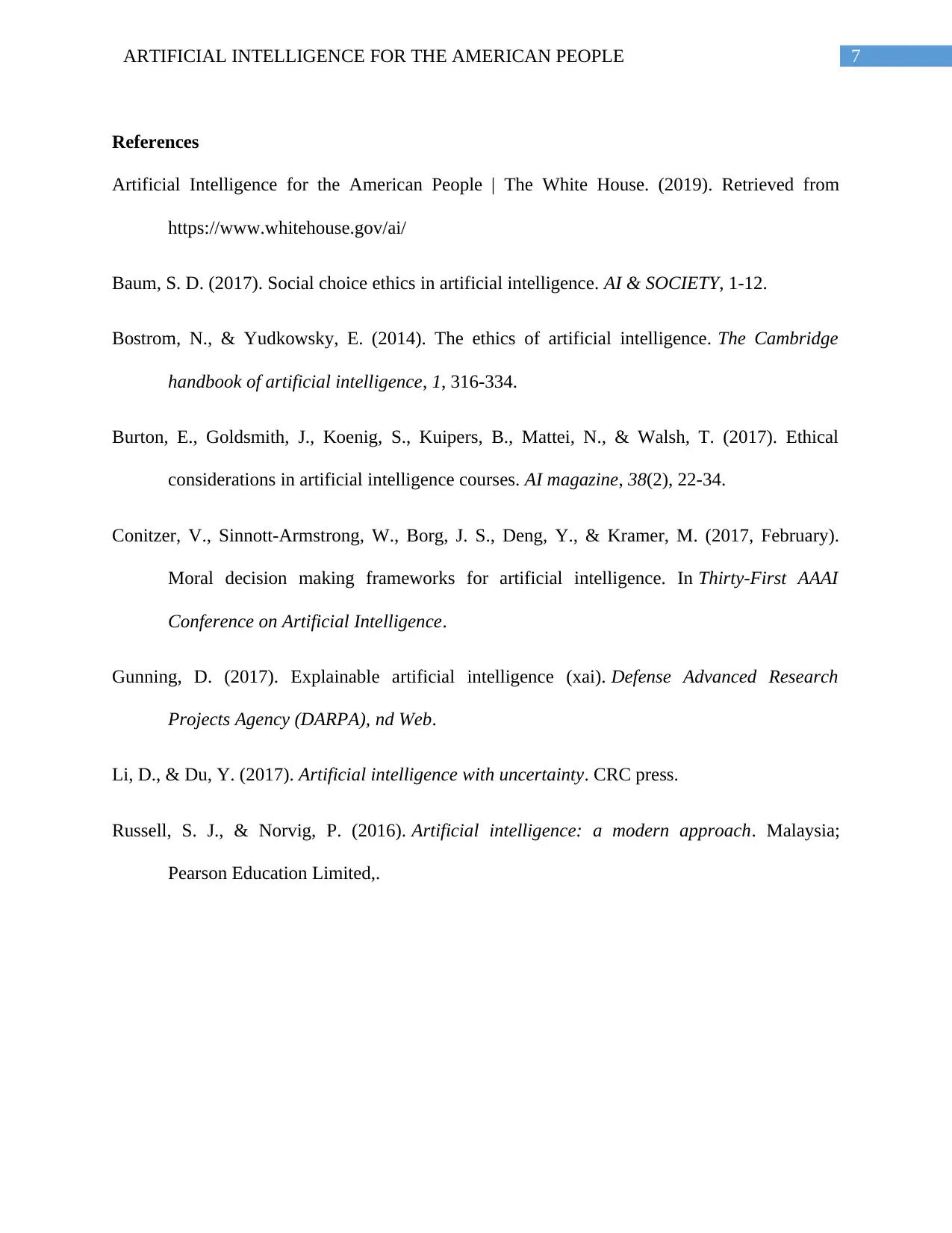
7ARTIFICIAL INTELLIGENCE FOR THE AMERICAN PEOPLE
References
Artificial Intelligence for the American People | The White House. (2019). Retrieved from
https://www.whitehouse.gov/ai/
Baum, S. D. (2017). Social choice ethics in artificial intelligence. AI & SOCIETY, 1-12.
Bostrom, N., & Yudkowsky, E. (2014). The ethics of artificial intelligence. The Cambridge
handbook of artificial intelligence, 1, 316-334.
Burton, E., Goldsmith, J., Koenig, S., Kuipers, B., Mattei, N., & Walsh, T. (2017). Ethical
considerations in artificial intelligence courses. AI magazine, 38(2), 22-34.
Conitzer, V., Sinnott-Armstrong, W., Borg, J. S., Deng, Y., & Kramer, M. (2017, February).
Moral decision making frameworks for artificial intelligence. In Thirty-First AAAI
Conference on Artificial Intelligence.
Gunning, D. (2017). Explainable artificial intelligence (xai). Defense Advanced Research
Projects Agency (DARPA), nd Web.
Li, D., & Du, Y. (2017). Artificial intelligence with uncertainty. CRC press.
Russell, S. J., & Norvig, P. (2016). Artificial intelligence: a modern approach. Malaysia;
Pearson Education Limited,.
References
Artificial Intelligence for the American People | The White House. (2019). Retrieved from
https://www.whitehouse.gov/ai/
Baum, S. D. (2017). Social choice ethics in artificial intelligence. AI & SOCIETY, 1-12.
Bostrom, N., & Yudkowsky, E. (2014). The ethics of artificial intelligence. The Cambridge
handbook of artificial intelligence, 1, 316-334.
Burton, E., Goldsmith, J., Koenig, S., Kuipers, B., Mattei, N., & Walsh, T. (2017). Ethical
considerations in artificial intelligence courses. AI magazine, 38(2), 22-34.
Conitzer, V., Sinnott-Armstrong, W., Borg, J. S., Deng, Y., & Kramer, M. (2017, February).
Moral decision making frameworks for artificial intelligence. In Thirty-First AAAI
Conference on Artificial Intelligence.
Gunning, D. (2017). Explainable artificial intelligence (xai). Defense Advanced Research
Projects Agency (DARPA), nd Web.
Li, D., & Du, Y. (2017). Artificial intelligence with uncertainty. CRC press.
Russell, S. J., & Norvig, P. (2016). Artificial intelligence: a modern approach. Malaysia;
Pearson Education Limited,.
1 out of 8
Related Documents
Your All-in-One AI-Powered Toolkit for Academic Success.
+13062052269
info@desklib.com
Available 24*7 on WhatsApp / Email
![[object Object]](/_next/static/media/star-bottom.7253800d.svg)
Unlock your academic potential
Copyright © 2020–2025 A2Z Services. All Rights Reserved. Developed and managed by ZUCOL.





